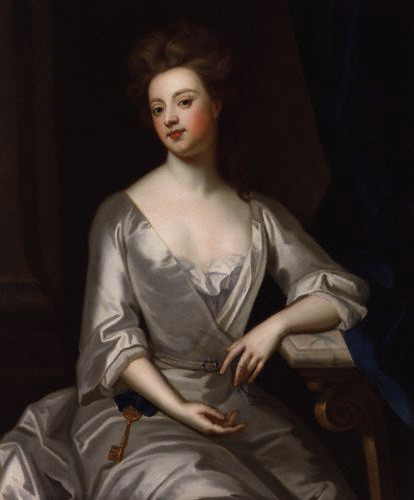 Being a pregnant woman in the 18th century probably delivers frightening images to most people. But I will state, loosely, it wasn't too bad. New thoughts and inventions made the uncomfortable journey of pregnancy safer than it had been in previous centuries and safer than what pregnant women would face in the following century. The mother mortality rate was lower than the high it would go through in the Victorian era of about 40%. Of course, pregnancy still wasn't all fun and games.
Being a pregnant woman in the 18th century probably delivers frightening images to most people. But I will state, loosely, it wasn't too bad. New thoughts and inventions made the uncomfortable journey of pregnancy safer than it had been in previous centuries and safer than what pregnant women would face in the following century. The mother mortality rate was lower than the high it would go through in the Victorian era of about 40%. Of course, pregnancy still wasn't all fun and games.Pregnant women were encouraged to remain active and even exercise rather than remain bed-ridden. Dr. William Buchan, in his 18th century version of What to Expect While You are Expecting, noted how poorer women aren't allowed a day off when pregnant and tend to have healthy births, and therefore recommended walks and carriage-rides for the privileged sect.
Comfort is always a factor during pregnancy and this doesn't hold any less truth for the 18th century woman. Unlike the women of the Victorian age who were given no excuse to go corset-less, Georgian women didn't let
 their underwear endanger their or their child's house during pregnancy. Pregnancy stays featured lacings on the sides in order to loosen up for expanding bellies. Sarah, Duchess of Marlborough couldn't stand her stays when she was pregnant and opted for a man's waistcoat instead! When her Grace had to go out she stated that she, "never went abroad but with a long black scarf to hide me I was so prodigeous big." But not everyone wanted to hide that belly. Georgiana began the trend for false stomachs during her sister's pregnancy. So many women were walking around with a cork belly amongst real pregnant women who could let it all hang out due to this latest fashion trend. How convenient!
their underwear endanger their or their child's house during pregnancy. Pregnancy stays featured lacings on the sides in order to loosen up for expanding bellies. Sarah, Duchess of Marlborough couldn't stand her stays when she was pregnant and opted for a man's waistcoat instead! When her Grace had to go out she stated that she, "never went abroad but with a long black scarf to hide me I was so prodigeous big." But not everyone wanted to hide that belly. Georgiana began the trend for false stomachs during her sister's pregnancy. So many women were walking around with a cork belly amongst real pregnant women who could let it all hang out due to this latest fashion trend. How convenient!At the forefront of pregnancy scientific breakthroughs was William Smellie. While forceps had been invented previously, Smellie
 redesigned them to be more efficient in the task of difficult deliveries. This innovation saved the lives of both mothers and children. In 1754 with the help of Dutch artist, Jan van Rymsdyk, Smellie published an atlas of women's anatomy with some graphic images. The book was eye-opening to many and was advantageous to understanding the process of birth.
redesigned them to be more efficient in the task of difficult deliveries. This innovation saved the lives of both mothers and children. In 1754 with the help of Dutch artist, Jan van Rymsdyk, Smellie published an atlas of women's anatomy with some graphic images. The book was eye-opening to many and was advantageous to understanding the process of birth.When a birth began to go horribly wrong, a cesarean section was the last option. This usually meant the death of the mother. There is one story of an American woman who begged for a C-section when she decided her death was imminent. Her doctor/midwife refused but her doctor-husband jumped in right away. He put her to sleep with a large dose of laudanum, opened her up and took out a baby girl, as well as his wife's ovaries in the hope that she would, "not be subjected to such an ordeal again." He then stitched her up and she survived the whole ordeal becoming the first person to survive a C-section in the United States.
Although some of the medieval tactics of pregnancies and birthing were still at large in the form of things such as bleeding a mother during labor, there was an obvious improvement in the process. Of course sweat pants, epidurals, and sanitation are a nicer improvement, but it was a start!

More than one slave - having suffered from rickets in her youth - was subjected to C-section in the U.S. during the 17th, 18th and 19th centuries. The ladies were given two or three days to recoup and then were expected to get back to work. And so they did. Amazing how hearty a soul can be when she isn't allowed to act like a diva.
ReplyDeleteThere is a spelling mistake in the title.
ReplyDelete@Pauline, how very kind that they were allowed 3 days, what generous slave-owners.
ReplyDelete@Anon, Thanks for the catch!
Poor slaves):
ReplyDeleteI laugh when I think how a diva would act when subjected to slave labor nowadays(:
I don't comprehend why anyone would wear a fake pregnancy belly, even if it's made of cork.
ReplyDeleteThank you SO much for this!!!! You Rock!!!!!
ReplyDeleteWow, this sort of information will help with my Novels, plus the history of it all is so interesting, thanks so much :)
ReplyDelete